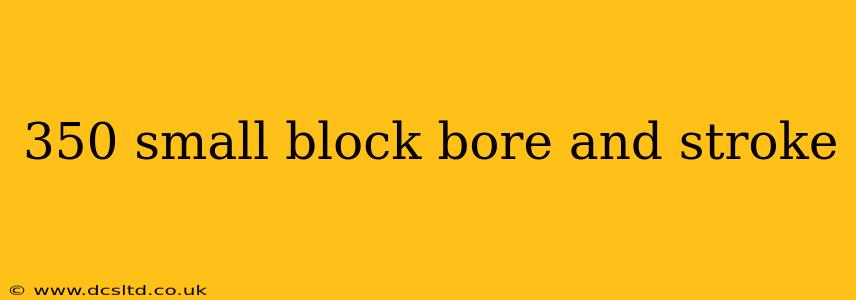The Chevrolet small-block 350, a legendary engine in automotive history, boasts a reputation for power, reliability, and modifiability. Understanding its bore and stroke dimensions is crucial for anyone working on, modifying, or simply appreciating this iconic engine. This article delves into the specifics of the 350 small block's bore and stroke, addressing common questions and providing insightful information for both enthusiasts and mechanics.
What is the standard bore and stroke of a 350 small block Chevy?
The standard bore and stroke for a 350 cubic inch small-block Chevrolet engine is 4.00 inches bore and 3.48 inches stroke. This combination, multiplied by the number of cylinders (8) and a constant factor, yields the engine's displacement of 350 cubic inches. This is the configuration most commonly found in production vehicles. However, it's important to note that variations exist depending on the year of manufacture and specific application.
What are the different bore and stroke combinations available for a 350 small block?
While the 4.00" bore and 3.48" stroke is the standard, aftermarket parts and various production runs have introduced slight variations. Some performance-oriented versions might have slightly larger bores achieved through honing or aftermarket cylinder blocks, resulting in increased displacement. Conversely, some applications might use slightly different dimensions to optimize performance characteristics. Therefore, always verify the exact dimensions for any specific engine you're working with. Checking the casting number on the engine block is the most reliable method for identifying these variations.
How does bore and stroke affect engine performance?
The bore and stroke dimensions significantly impact an engine's performance characteristics. A longer stroke generally produces more torque at lower RPMs, resulting in a "stronger" feeling engine, especially beneficial for towing or hauling. A shorter stroke, conversely, allows for higher RPMs and generally favors horsepower at higher engine speeds, beneficial for racing or high-performance applications. A larger bore allows for increased valve size and increased airflow into the combustion chamber. The optimal combination depends heavily on the intended use of the engine.
Can you increase the bore and stroke of a 350 small block?
Yes, increasing the bore and stroke of a 350 small block is a common modification among enthusiasts and performance builders. Increasing the bore is achieved through honing the existing cylinders, using oversized pistons, and potentially employing aftermarket cylinder sleeves. Increasing the stroke requires a crankshaft with a longer stroke length. Both modifications increase the engine’s displacement, resulting in a significant power increase. However, these modifications require careful planning and execution to maintain engine reliability. Excessive modifications can lead to decreased engine lifespan or even catastrophic failure.
What are the benefits of increasing the bore and stroke?
Increasing the bore and stroke directly increases the engine's displacement. More displacement generally equates to more power and torque. However, it's crucial to consider the associated costs and potential risks. Larger bores might require cylinder sleeving, which is more expensive and potentially less durable than simply honing the existing cylinders. Similarly, longer stroke crankshafts often come with a higher price tag and require careful consideration of the connecting rod length and piston design to prevent interference.
What are the risks of increasing the bore and stroke?
Increasing the bore can weaken the cylinder walls, leading to potential cracking or deformation under high stress. Increasing the stroke can cause problems with piston-to-valve clearance if not carefully planned, potentially resulting in damaging collisions between the pistons and valves. Both modifications can also impact the engine's reliability and durability if not performed correctly, possibly requiring more frequent maintenance. Therefore, careful planning, precise execution, and potentially some compromises in other areas are crucial for successful modification.
This detailed look into the bore and stroke of the 350 small block Chevy engine clarifies this fundamental aspect of engine design and modification. Understanding these dimensions and their impact is a cornerstone of successful engine building and tuning. Remember always to consult with experienced engine builders for complex modifications to ensure reliability and achieve your desired performance goals.
